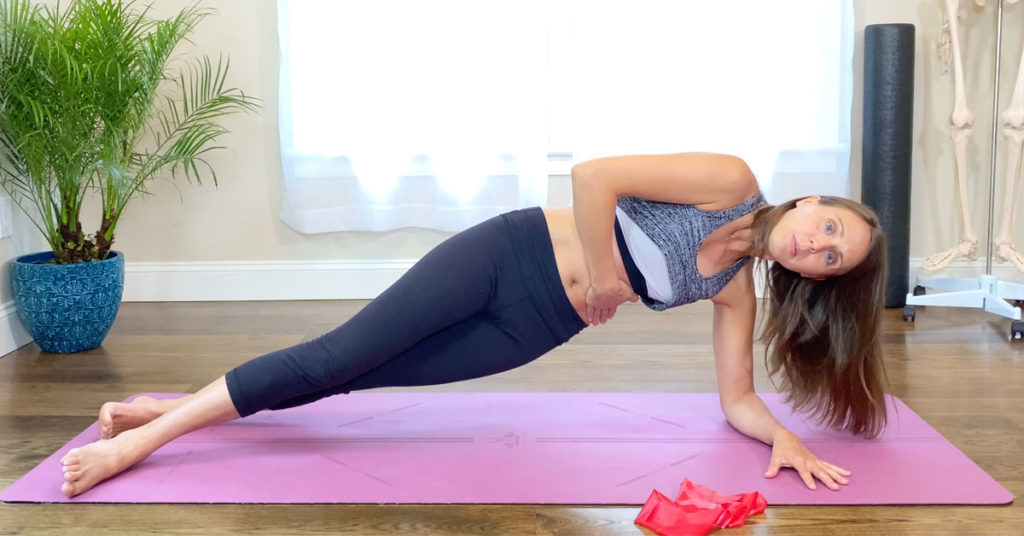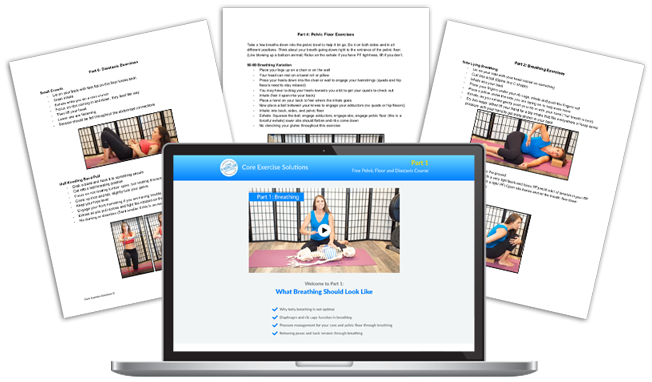What Is Rib Flare and Why Should You Care?
Rib flare is a term that is often thrown around in the rehab world. Understanding what it means and how you can fix it can go a long way toward better breathing, core strength, and overall posture. Rib flare can even play a role in neck, hip and back pain!
The confusing part is that rib flare can refer to two different things. One is rib positioning, and the other is rib angle (also known as the ISA or infrasternal angle). So let’s break this down a bit and see if we can make sense of it.
Rib Flare After Pregnancy and Ribs That Stick Out After Pregnancy
Rib flare can be caused by a variety of things, but almost every postpartum woman I see has some degree of rib flare. The internal organs move around to make room for the baby, so the rib cage flares and the pelvis widens. Some women naturally go back to their pelvis and rib cage resting position postpartum, and some don’t. That has a lot to do with genetics and how you naturally move your body. If you find yourself needing a larger bra setting around your rib cage postpartum (maybe you used to be a 34 and now you’re a 36), then you would benefit from some rib cage mobility exercises!
We can actually change the shape and diameter of the rib cage and pelvis to some degree. Nothing in the body is fixed! You just need the right stimulus, i.e., exercises, to drive the change you’re looking for.
Rib Cage Positioning
Rib Cage Flare Out to Front
This is when your posture affects the positioning of your rib cage. Try it now with me….
- Really stick out your chest like you’re a kid trying to show someone your belly button.
- Now try and hide your chest, like you’re a young girl wanting to hide her breasts.
- Then let your hips drift forward and completely relax, and sag like you’re a tired mom at the park.
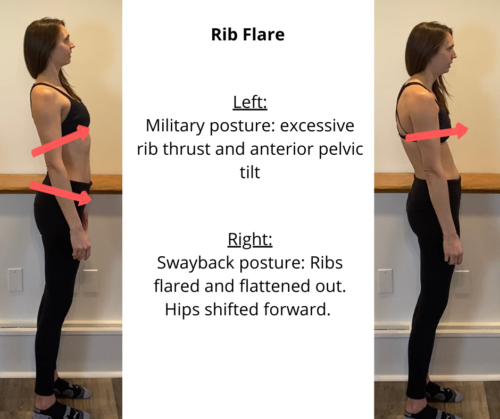
Do you feel how each body position changes the position of your rib cage?
Sometimes posture is simply a habit of how we hold our body, and sometimes tightness or restrictions are forcing us into certain positions. There is no such thing as perfect posture, but having the rib cage lined up with the pelvis and optimizing the ISA (front rib cage angle) helps the body function a bit better since the diaphragm plays off the pelvic floor and vice versa.
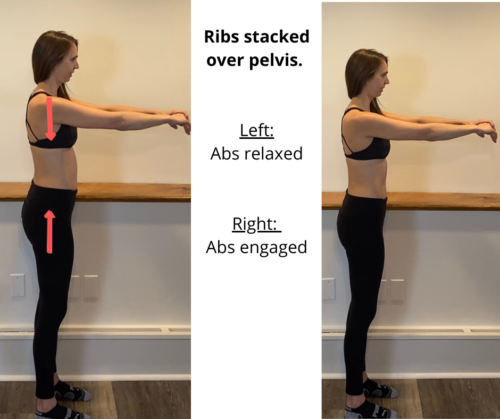
Think of when an engine belt in a car is “off.” The car will still run, but you get that annoying squeaky noise. If you have less than optimal posture most of the day, your body will start to squeak at you in the form of aches and pains or perhaps diastasis and pelvic floor issues that won’t improve.
The worst thing you can do when trying to improve your posture is go overboard. Trying to hold perfect posture rigidly throughout the day makes the body lock down and creates more dysfunction. Great posture is fluid and variable, so don’t get hung up on one exact position but do focus on what you feel. Where is your body in space? Does it feel good? Do you feel relaxed, or are you holding tension? Let that tension go, including ab gripping!
Rib Flare and Breathing
Rib Cage Infrasternal Angle
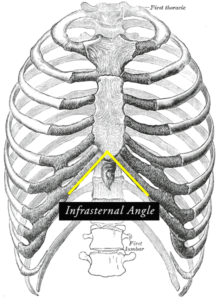
This type of rib flare is a bit harder to address because it requires changing how muscles fire versus their position from front to back.
You have small muscles, called the internal intercostals, that run between your ribs. These muscles work with the abdominals to produce a forced exhale. I often find that women who have a larger rib cage infrasternal angle (wide ISA) postpartum are stuck in a state of inhalation. (Meaning, it always looks like they are sucking air in.) When you don’t move a part of the body regularly, like your ribs or spine, it can get stiff and present with some difficulty moving out of that position. Pregnancy pushes the ribs up and out (into a state of inhalation) to make room for the baby, so it often takes a bit of manual pressure and coaxing through specific exhalation exercises to get those ribs back down and in.
Rib Cage Flare Out to Sides
A wide ISA, or rib cage flared out to the sides, prevents someone from getting a good inhale because they are stuck up in an already inhaled state. From a rehab perspective, I like to start with working the exhale and coaxing those ribs into movement. Your ISA (front angle of the rib cage) should change with each breath. On the inhale it should widen, and on the exhale it should narrow. Being stuck narrow or wide with limited movement for breathing is something you’ll want to address.
What Causes Rib Flare on One Side?
If you find yourself looking in the mirror at one side of your rib cage and see it sticks up more or rests at a flatter angle, this is one-sided rib flare. Most people have some left rib flare due to the diaphragm attaching lower on the right side. It’s just easier for the body to keep that right rib tucked in. It’s fun to think about how we’re not even on the inside, so why should we expect to be naturally even on the outside?
Unfortunately, one-sided rib flare can lead to neck and back tightness as well as a rotation in the pelvis. But there are exercises that can help get that flared side back in and responding well to breathing!
Pelvic Floor Rib Flare
Pelvic floor tightness can promote a state of inhalation. Crazy, right, that a little tightness in the pelvic floor can actually decrease the amount the diaphragm expands down, leaving your diaphragm stuck up and ribs stuck out?
As the diaphragm contracts down on the inhale, it helps to stimulate our vagus nerve which is our “chill-out” center. It’s no wonder pelvic floor tightness can increase anxiety! The psoas (deep hip flexor muscle) that attaches into the back of the diaphragm has been coined the “emotional muscle,” probably for a similar reason. If you’re always in a shallow breathing pattern, usually spurred on by paradoxical breathing, then you never release the top of the psoas through great back (not belly) diaphragm expansion. Getting those ribs down and in and getting a great exhale can go a long way for both our physical and emotional states.
Diastasis Recti Rib Flare
I hope this helps explain the meaning of rib cage flare or rib cage angle and gives you a helpful point of reference for reflecting on your posture!
How to Fix Rib Flare
Rib Flare Test
Lie on your back and take a few deep breaths, letting your organs settle and abdominals relax. This will create a clearer rib cage picture. Then have someone snap a picture looking down at your ribs. You can take that picture and outline your infrasternal angle (the angle the ribs come together in the front).
The optimal angle is 90 degrees. A wide ISA is greater than 110, and narrow is less than 90. One other thing to note is whether or not this angle changes as you breathe. Does it increase when you inhale and decrease when you exhale, or does it stay the same?
Rib Flare Exercises
One of the best ways to improve rib flare is to focus on your exhale. If you get a great exhale, then it’s easier to get a good inhale. Think of it as creating space. So whether you have a wide ISA and you’re trying to get those ribs in or it’s narrow and you’re trying to expand out, working the exhale can help!
If you have a wide ISA, focus on your ribs coming in and down, compressing the sides on the exhale. Be sure to get a nice pause at the end of your exhale. If you have a narrow ISA, focus on getting a complete exhale, but think more about the front coming in than the sides. Then, with each inhale you can expand the sides and focus on the front coming in more on the exhale.
To keep it simple: those with a wide ISA need more side squishing, and those with a narrow ISA need more front to back squishing.
Are you a professional that works with women? Check out the Pregnancy and Postpartum Corrective Exercise Specialist Certification. This Course is the world’s leading women-focused corrective exercise certification for fitness and healthcare professionals.
Working with pregnant and postpartum clients/patients?
This 6-part course offers key takeaways on breathing, pelvic floor strengthening and diastasis recovery. Sign up and start learning today!

